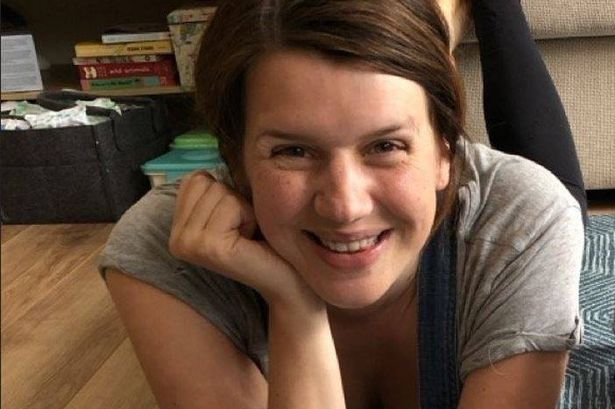
The inquest into the deaths of Jennifer Cahill and daughter Agnes in June 2024 continued at Rochdale Coroners’ Court on Friday
Jennifer Cahill(Image: Men Media)
The cause of death of a young mum who lost her life shortly after giving birth at her Prestwich home has been disclosed in court. The inquest into the deaths of Jennifer Cahill and newborn daughter Agnes in June 2024 continued at Rochdale Coroners’ Court on Friday (October 17).
Jennifer, 34, died the day after she gave birth, and never got to hold Agnes, who lived for four days before she, too, tragically died.
Pathologist Lisa Barker spoke to the court via videolink about the findings of the post-mortem examination on Jen. Dr Lisa Baker told the court that in her 20 years as a pathologist she had ‘gradually built up quite an extensive experience with maternal deaths’.
She said she found fluid in Jennifer’s chest, lungs and kidneys, ‘consistent with multi-organ failure’. She also noted she found a three-centimetre tear in Jennifer’s vagina.
Her suggested cause of death was ‘multi-organ failure due to cardiac arrest, due to postpartum haemorrhage’.
Join the Manchester Evening News WhatsApp group HERE
Evidence was also read out in relation into the investigation of Jennifer’s activity on a home birth Facebook group. A statement from detective inspector Julie Adams of Bury police station was read by coroner Joanne Kearsley.
The ‘Home Birth Support Group UK’ group described itself as ‘without a doubt the most comprehensive, supportive Home Birth and birthing resource on the internet’.
Although police were unable to gain access, officers were provided with screenshots from a member of the public who came forward after following the media coverage of the inquest.
Jennifer died during childbirth(Image: Men Media)
The court heard Jennifer posted in the group on December 8, 2023. Det Insp Adams said she ‘asked questions to the group about her own pregnancy and the comments were giving advice’.
The court was told Greater Manchester Police had spoken to an admin of the group, Samantha Gadsden, and she told police that ‘she doesn’t recall any previous conversations with Jen’.
Ms Kearsley noted that the group’s description stated no medical advice was given. Also taking to the witness stand were North West Ambulance Service staff who attended the Cahill’s Bury home on June 3, 2024.
Senior paramedic Sean Scroop; paramedic Adrian George; and emergency medical technician (EMT) Leah Brennan addressed the court.
It was described as ‘once in a career incident that you would have to attend’ for the emergency service workers. Mr Scroop first to arrive at the scene.
He transported baby Agnes to hospital after helping community midwife Julie Taylor resuscitate her. Mr George and Ms Brennan, who was a trainee at the time, were tasked with staying at the home to make observations; support the midwives; and transfer her to North Manchester General Hospital.
Mr Scroop, who was the first to arrive at the scene, primarily cared for baby Agnes, although he told the court that he was able to have a ‘look’ at Jennifer who was a ‘good colour’.
The experienced paramedic told the court he ‘instructed’ that the windows be opened and lights switched on as he entered the dimly lit home, where he found midwife Ms Taylor attempting to resuscitate baby Agnes.
The court heard the umbilical cord was still attached to Agnes as Ms Taylor performed chest compressions on the newborn. Mr Scroop said that the midwives left the cord attached as ‘they wanted as much blood going to Agnes as possible’.
He noted midwife Ms Taylor had been struggling to adequately stimulate baby Agnes due to a fault with her equipment. He told the court he eventually took over and instructed the midwife ‘to clamp and cut the umbilical cord’.
Describing the action he took to revive Agnes, he said: “I moved her to open her airways better. She did take her first breath and she started to pink up nicely.”
Two ambulances were called to the home. Mr Scroop said Jennifer’s husband Robert rode with him as Agnes – who was ‘showing positive signs’ – was rushed to hospital.
He told the court he and Robert were unaware Jennifer had begun bleeding minutes after they had departed. Paramedic Mr George told the court he was made aware of Jennifer’s history of postpartum haemorrhage during a brief conversation with the midwives.
He told the court he witnessed Jennifer’s health ‘deteriorate’ while she was in his care. The court that how when he first arrived, Jennifer showed no signs of ‘external bleeding. “What I saw wasn’t any more than what could be expected in that situation,” Mr George added.
But as preparations were made to take Jennifer to the hospital, Mr George said she became ‘agitated’. As he attempted to move her, she ‘appeared to lose strength in her legs’ and became ‘lethargic’, eventually losing consciousness, he added.
Mr confirmed he witnessed Jennifer suffer blood loss through the delivery of her placenta’ and that in a conversation in the ambulance, a midwife said she had lost around ‘two litres of blood’.
Asked if more could have been done in observing and providing Jennifer with medication, Mr George said: “Ideally, she should have had more observations, but she wanted us to leave her alone. I was comfortable with respecting her wishes to be left alone.”
EMT Ms Brennan, noted the difficulties she and her colleagues had gaining access to the family’s home as well as geeting a wheelchair to move Jennifer into the ambulance.
Asked about what she remembered of Jennifer’s initial wellbeing before she took a turn, she said: “She looked okay. She was a good colour. She was engaging with us as much as she wanted to. She looked like a woman who had just given birth, that’s the best way to describe it. But not acutely unwell.”
The inquest resumes next week.





